new posts in all blogs
Viewing: Blog Posts Tagged with: earleywine, Most Recent at Top [Help]
Results 26 - 50 of 65
How to use this Page
You are viewing the most recent posts tagged with the words: earleywine in the JacketFlap blog reader. What is a tag? Think of a tag as a keyword or category label. Tags can both help you find posts on JacketFlap.com as well as provide an easy way for you to "remember" and classify posts for later recall. Try adding a tag yourself by clicking "Add a tag" below a post's header. Scroll down through the list of Recent Posts in the left column and click on a post title that sounds interesting. You can view all posts from a specific blog by clicking the Blog name in the right column, or you can click a 'More Posts from this Blog' link in any individual post.

By: DanP,
on 7/14/2014
Blog:
OUPblog
(
Login to Add to MyJacketFlap)
JacketFlap tags:
natural history,
ecology,
conservation,
mary blair,
endangered species,
primate,
animal conservation,
threatened species,
Editor's Picks,
*Featured,
Science & Medicine,
Earth & Life Sciences,
animal population,
exotic pet trade,
illegal animal trading,
primate ecology and conservation,
slow loris,
slow lorises,
loris,
lorises,
nycticebus,
Books,
Add a tag
By Mary Blair
Slow lorises are enigmatic nocturnal primates that are notoriously difficult to find in the wild. The five species of slow loris that have been evaluated by the International Union for the Conservation of Nature’s Red List of Threatened Species are classified as threatened or critically endangered with extinction. So, how did one end up recently on the set of Lady Gaga’s music video? Lorises don’t make good pets or video props, especially as they are the world’s only venomous primates. But, unfortunately, it is easier to see a loris as an exotic pet in a Youtube video or on Rihanna’s shoulder as a photo prop than it is to see them in the wild.
In my current research at the Center for Biodiversity and Conservation at the American Museum of Natural History, my team is surveying for Bengal (Nycticebus bengalensis) and pygmy slow lorises (N. pygmaeus) in Vietnam to determine their population status – how many lorises remain across different key sites in Vietnam, and how their current numbers compare to previous surveys. I have written before about the challenges my team has faced searching for these elusive creatures, but this time, I’d like to discuss the broader difficulties of searching for low-density, rare animals, and how knowledge gaps about these creatures can preclude the development of effective management plans for their conservation.
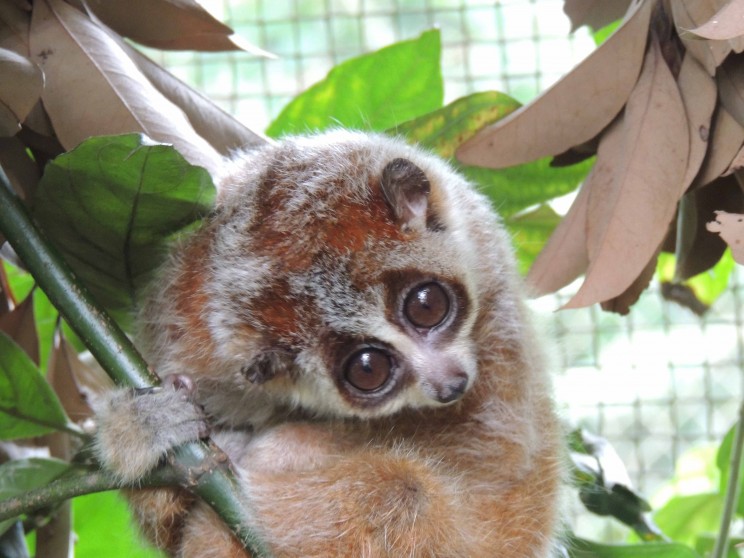
Intensive fieldwork on Vietnam’s primates only began in the mid-1990s, focusing on those species assessed to be the most in danger of extinction, especially gibbons (Nomascus spp.) and colobines such as snub-nosed monkeys (Rhinopithecus avunculus), doucs (Pygathrix spp.), and leaf monkeys (Trachypithecus spp.). Comparatively little research to date has focused on species assumed to be common such as the macaques (Macaca spp.) and the nocturnal lorises (Nycticebus spp.). These groups are presumed common because they seem to be able to persist in more diverse habitats including agroforest and regenerating forest, while gibbons, doucs, snub-nosed and leaf monkeys are found in established primary or secondary forests, which are rapidly depleting in Vietnam. As a result of this assumption, very few studies have focused on macaques or lorises in Vietnam and thus, there is very little if any information available to accurately assess their conservation status.
Now that researchers have started collecting data more intensively on slow lorises in Vietnam, we are finding that they are at such low densities that it is difficult to accurately calculate their density with statistical precision. However, as more and more researchers choose to focus on nocturnal, rare mammals like lorises across the globe (from owl monkeys to galagos to colugos), we can synthesize across our efforts to learn from each other, refine our methods, and generate more appropriate statistical models. In addition to continuing our surveys, we also working to raise awareness about threats to slow loris populations in Vietnam, and we are training local forest rangers and researchers to conduct ongoing population monitoring.
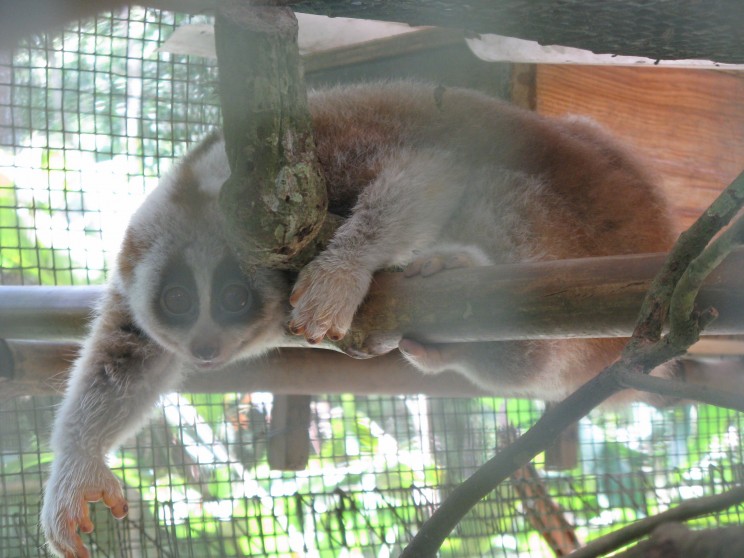
Ironically, in this case, there was the least information available about the animals assumed to be the most common. Without fundamental data on population status or distribution, it is difficult to either build effective conservation management plans for slow lorises or attract the federal and private funding necessary to implement such plans. And as such, major conservation actions in the region to date have focused on higher profile primate species, for which there is more information about conservation status. We are finally moving towards having enough scientific information to design a plan of action for improved conservation management of slow loris populations in Vietnam.
In Indonesia, at least 15,000 lorises are trafficked each year for the exotic pet trade. Numbers are not available for Vietnam or other countries in Mainland Southeast Asia, but our work so far suggests that pressure from the trade remains quite high. Our upcoming work in Vietnam, funded by the US National Science Foundation, will expand our research to include social science approaches to better inform policy makers about the underlying social and economic drivers of illicit trade in lorises. You can learn more about what other intrepid loris researchers are doing and how you can help to raise awareness and decrease demand for these endangered animals as exotic pets and photo props.
Dr. Mary Blair is the Assistant Director for Research and Strategic Planning at the Center for Biodiversity and Conservation at the American Museum of Natural History. Her research explores how knowledge of evolutionary processes can inform conservation planning. Her work in Vietnam is supported in part by the Disney Worldwide Conservation Fund and by a US National Science Foundation Science, Engineering, and Education for Sustainability Fellowship under Grant No. NSF-CHE-1313908. Mary has blogged about her work in Vietnam for the Museum’s Fieldwork Journal and for the New York Times, and is the author of Primate Ecology and Conservation. You can follow Mary on Twitter @marye_blair. Any opinions, findings, and conclusions or recommendations expressed in this material are those of the author and do not necessarily reflect the views of the U.S. National Science Foundation.
Subscribe to the OUPblog via email or RSS.
Subscribe to only earth and life sciences articles on the OUPblog via email or RSS.
Image credits: (1) A pygmy slow loris (Nycticebus pygmaeus) at the Endangered Primate Rescue Center in Cuc Phuong National Park, Vietnam. Photo by Dr. Mary Blair. Do not reproduce without permission. (2) A Bengal slow loris (Nycticebus bengalensis) at the Endangered Primate Rescue Center in Cuc Phuong National Park, Vietnam. Photo by Nolan Bett, used with permission.
The post Tracking down a slow loris appeared first on OUPblog.


By: Kirsty,
on 6/23/2014
Blog:
OUPblog
(
Login to Add to MyJacketFlap)
JacketFlap tags:
diversity,
Journals,
tiger,
conservation,
tigers,
zoos,
*Featured,
oxford journals,
tiger conservation,
Science & Medicine,
inbreeding,
journal of heredity,
genetic,
life sciences,
Earth & Life Sciences,
animal sciences,
rachael a. bay,
tiger management,
rachael,
‘inbreeding,
Add a tag
By Rachael A. Bay
For tigers, visiting your neighbor is just not as easy as it used to be. Centuries ago, tigers roamed freely across the landscape from India to Indonesia and even as far north as Russia. Today, tigers inhabit is just 7% of that historical range. And that 7% is distributed in tiny patches across thousands of kilometers.
Habitat destruction and poaching has caused serious declines in tiger populations – only about 3,000 tigers remain from a historical estimate of 100,000 just a century ago. Several organizations are concerned with conserving this endangered species. Currently, however, all conservation plans focus increasing the number of tigers. Our study shows that, if we are managing for a future with healthy tiger populations, we need to look beyond the numbers. We need to consider genetic diversity.
Genetic diversity is the raw material for evolution. Populations with low genetic diversity can have lower health and reproduction due to ‘inbreeding effects’. This was the case with the Florida panther – in the early 1990s there were just 30 Florida panthers left. Populations with low genetic diversity are also vulnerable when faced with challenges such as disease or changes in the environment.
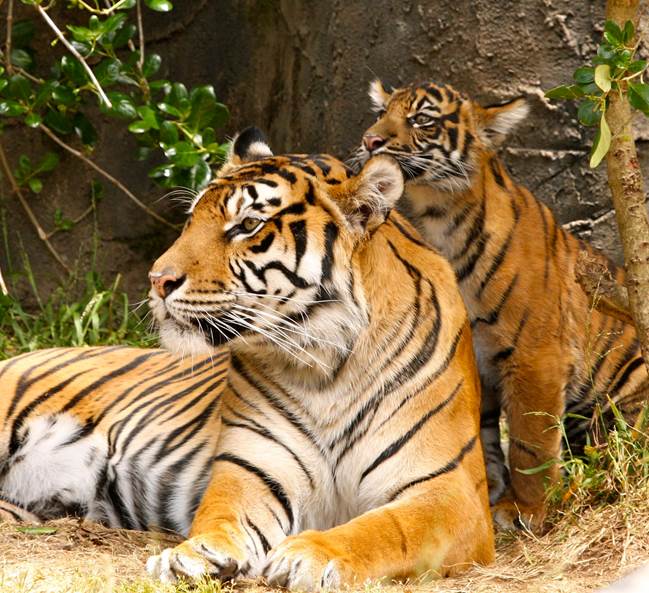
Photo by Rachael A. Bay
Luckily for tigers, they don’t have low genetic diversity. They have very high genetic diversity, in fact. But the problem for tigers is that losing genetic diversity happens more quickly in many small, disconnected populations than in one large population. The question is: how can we keep that genetic diversity so that tigers never suffer the consequences of inbreeding effects.
We used computer simulations to predict how many tigers we would need in the future to keep the genetic diversity they already have. Our study shows that without connecting the small populations, the number of tigers necessary to maintain that variation is biologically impossible. However, if we can connect some of these populations – between tiger reserves or even between subspecies – the number of tigers needed to harbor all the genetic variation becomes much smaller and more feasible. Case studies have shown that introducing genetic material from distantly related populations can hugely benefit the health of a population in decline. In the case of the Florida panther, when individuals from another subspecies were introduced into the breeding population, the numbers began to rise.
We do need to increase the number of tigers in the wild. If we can’t stop poaching and habitat destruction, we will lose all wild tigers before we have a chance to worry about genetic diversity. But in planning to conserve this majestic animal for future generations we should make sure those future populations can thrive – and that means trying to keep genetic variation.
Rachael A. Bay is a PhD candidate at Stanford University, and co-author of the paper ‘A call for tiger management using “reserves” of genetic diversity’, which appears in the Journal of Heredity.
Journal of Heredity covers organismal genetics: conservation genetics of endangered species, population structure and phylogeography, molecular evolution and speciation, molecular genetics of disease resistance in plants and animals, genetic biodiversity and relevant computer programs.
Subscribe to the OUPblog via email or RSS.
Subscribe to only earth and life sciences articles on the OUPblog via email or RSS.
Image credit: Tigers at San Francisco Zoo. Photo by Rachael A. Bay. Do not reproduce without permission.
The post Investing for feline futures appeared first on OUPblog.

Title: Wild About Bears By Jeannie Brett Published by Charlesbridge, March 2014 Ages: 6-9 Themes: Bears Nonfiction Opening Lines: Eight bear species live on earth today: the polar bear, brown bear, North American black bear, spectacled bear, Asiatic black bear, sloth … Continue reading →
By:
Sue Morris,
on 4/17/2014
Blog:
Kid Lit Reviews
(
Login to Add to MyJacketFlap)
JacketFlap tags:
a changing world,
Abayomi,
Darci Pattison,
forest depletion,
pumas,
Children's Books,
Picture Book,
NonFiction,
Series,
Brazil,
wildlife,
conservation,
wisdom,
5stars,
Mims House,
Library Donated Books,
Kitty Harvill,
Add a tag
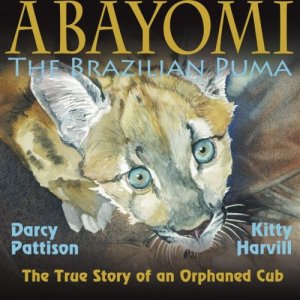 .
.
Abayomi, the Brazilian Puma: The True Story of an Orphaned Cub
by Darci Pattison & Kitty Harvill, illustrator
Mims House 2014
978-1-62944-001-9
Ages 6 to 8 32 pages
.
“From the award-winning team that brought you WISDOM, THE MIDWAY ALBATROSS, comes a new heart-warming story of an orphaned puma cub. A mother puma, an attempt to steal a chicken, and an angry chicken farmer—the search is on for orphaned cubs. Will the scientists be able to find the cubs before their time runs out?
In this “Biography in Text and Art,” Harvill takes original photos as references to create accurate wildlife illustrations. Pattison’s careful research, vetted by scientists in the field, brings to life this true story of an infant cub that must face a complicated world alone—and find a way to survive.”
Opening
“In the far south, in Brazil, a puma cub was born in the early spring month of October 2012.”
The Story
Brazil, once covered by deep forests, now houses more people in cities and villages. To keep their cars moving more sugar plantations took over much of the remaining forest. Pumas, and other wild animals, must live closer to man and find it more difficult to hunt for food. One night, a female puma spotted some chickens in a farmer’s barn. Their normal diet of armadillos, capybaras, and ring-tailed coatis were getting hard to find. The puma needed to feed her cub and the chickens were easy prey. But she fell victim to a farmer’s trap. Before wildlife officials could get to the farm and safely remove the puma, she died.
Alone, hungry, and no mother to help, her cub had to hunt, but would he know how? Wildlife officials followed the mother puma’s trail trying to find her cubs but came up empty. Twenty-three days after his mom left and never returned, dogs a mile away from home cornered the cub. Dehydration and starvation ravished the cub’s body, stealing the energy he needed to walk. He staggered from place to place. This time wild life officials safely caught the cub, naming him Abayomi, which means happy meeting in the Tupi-Guarni native language. Scientists did what was needed so this little guy could return to the wild. Were they successful?
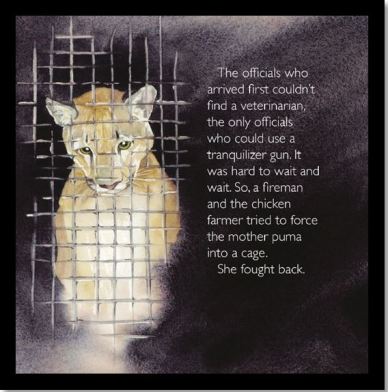
Review
The team of Darci Pattison and Kitty Harvill have made their second successful wildlife children’s book about a fascinating survivor. The first, Wisdom, the Midway Albatross, garnered starred reviews. Abayomi will undoubtedly do the same. With simple language and thoughtful prose, the story of Abayomi will come to life for schoolchildren, many of whom live in urban areas and have never seen a puma. Though the death of the mother puma was most likely gruesome, Pattison wrote,
“. . . She fought back. Once, she hit her head hard against the side of the cage and was dazed. After hours of struggling, she died.”
The illustrations were just as easy on the subject. You see the puma in a cage and some chickens in a roost, but nothing more. Not one spittle of blood mentioned or seen. Children should not experience nightmares after reading Abayomi. All of the illustrations are soft watercolor renditions of actual locations in this true story, completely vetted by experts. Each image is realistic yet gentle on the eyes. The scrawny cub, shown from the backside, does not noticeably display starvation. The hips are noticeably larger due to a lack of abdominal body fat, yet not so much as to scare even the youngest children.
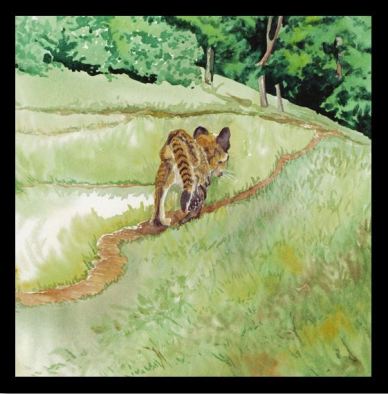
The book concludes with some facts about Abayomi, the Corridor Projects, and urbanization, along with some resources children can look up for more details. Children could write an interesting book report after reading Abayomi the Brazilian Puma. Pattison and Harvill make a splendid team that children, parents, and teachers should not ignore. Conservation and wildlife experts and scientists fact check Pattison’s research. Harvill uses photographs taken on site when painting her illustrations. The pair have made clear choices that make the books assessable to younger children, while still interesting older kids. (Yes, like myself.)
As with Wisdom, the Midway Albatross, Abayomi, the Brazilian Puma should be in school libraries and homeschooling bookshelves that cover wildlife, conservation, or the changing world. As starting points, Abayomi and Wisdom, are great resources for children. While not an expansive missive, these two books will guide students to other resources and further knowledge. The two books also allow younger children to learn about these subjects in a mild, non-scary manner that will peak curiosity, not provoke nightmares.

ABAYOMI, THE BRAZILIAN PUMA: THE TRUE STORY OF AN ORPHANED CUB. Text copyright © 2014 by Darci Pattison. Illustrations copyright © 2014 by Kitty Harvill. Reproduced by permission of the publisher, Mims House, Little Rock, AK.
.
Learn more about Abayomi, the Brazilian Puma HERE.
Get your copy of Abayomi, the Brazilian Puma at Amazon—B&N—Mims House—ask for it at your local bookstore.
.
Meet the author, Darci Pattison, at her website: http://www.darcypattison.com/
Meet the illustrator, Kitty Harvill, at her website: http://www.kharvillarte.com.br/artist.html
Find more Mims House stories at the publisher’s website: http://mimshouse.com/
.
Also by Darci Pattison

Saucy and Bubba, a Hansel and Gretel Tale

Vagabonds
.
.
.
.
.
.Also by Kitty Harvill
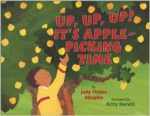
Up, Up, Up! It’s Apple-Picking Time
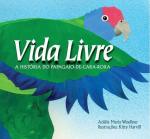
Vida Livre (published in Brazil)
.
.
.
.
.
Also New from Mims House

The Girl, the Gypsy, and the Gargoyle
.
.

Filed under:
5stars,
Children's Books,
Library Donated Books,
NonFiction,
Picture Book,
Series Tagged:
a changing world,
Abayomi,
Brazil,
conservation,
Darci Pattison,
forest depletion,
Kitty Harvill,
Mims House,
pumas,
wildlife,
wisdom 







How do you celebrate Earth Day in your home or classroom? (I know it's not Earth Day yet, but I'm posting this selection of books well in advance in case you are inspired to use them!) I believe that Earth Day should be every day, so going green at home or in the classroom should be a value that is instilled early and often.
For many kids and families, going green is a new way of thinking about the world, our place in it, and the choices we make. Today's trio of books offers simple suggestions for acting in a way that is Earth friendly.Poetry Book
The Green Mother Goose: Saving the World One Rhyme at a Time, written by Jan Peck and David Davis and illustrated by Carin Berger, presents 30 well-known nursery rhymes and children's songs, rewritten as parodies with an eco-friendly twist. Collectively these poems promote both healthy living and conservation activities. The rhymes deliver positive messages in an inventive and catchy way, though some readers may find a few of the poems didactic. The illustrations support the notion of going green in that they are composed of recycled materials, scraps of paper, and other ephemera. The book opens with this poem.
Green Mother GooseTogether we’ll do it—
We’ll help save the Earth,
Our emerald home,
The place of our birth.
Come now, rhyme with me,
Let’s turn our hearts loose,
And fly ‘round the world
With Green Mother Goose.
The rhymes cover a range of topics, including solar energy, reusable shopping bags, carpooling, organic gardening, replacing incandescent lightbulbs, and much more. Here's one more example.
Three Wise MiceThree wise mice,
Three wise mice,
See how they save!
See how they save!
They search for clothes at the thrift store shops,
Recycle the treasures at yard sale stops,
Catch water from rain and use all the drop.
Three wise mice!
Poems ©Jan Peck and David Davis. All rights reserved.Poetry and Informational Book 
What Can You Do With An Old Red Shoe?, written and illustrated by Anna Alter, is a green activity book that focuses on reusing household items in creative ways. This title is a wonderful combination of poetry and crafting for kids. Here's how the book begins.
This book is all about the ways in which you can reuse and recycle. Each project introduces an art activity that reuses materials you can find in your home. Some of the activities require the help of an adult.
Reusing is a fun way to reinvent worn items. It's also a great way to help conserve our natural resources (like the trees used to make paper) and create less trash to store in landfills. By finding new ways to use old things instead of throwing them away, we can help to keep the environment clean and healthy. If we share in the responsibility of taking care of our world, we can all enjoy it together!
There are a total of 12 activities for recycling old materials, 8 of which require some form of adult assistance. Materials given new life include a flip-flop, bits of old crayon, a worn blanket, empty tin cans, and more. Each double-page spread begins with a poem. Here's the one from the page that asks "What can you do with bits of old crayon?"
Trina is an artist
who doesn't like to stop.
She's colored the walls in her art room,
the bottom to the top.
The walls are one big canvas
and never look complete.
She's worn out all her crayons—
a great artistic feat.
After this readers will find a list of materials that are needed for the project. In this case Trina gathers:
- Lots of used crayons
- An old metal bowl or pot (used only for crafts)
- An ice cube tray
Next there are illustrated, step-by-step instructions for carrying out the project. The directions are clear, concise and simply written. For this project adult help is needed to heat the oven and to pour the hot, melted crayons into the ice cube trays.
At the end of the book readers will find tips for kids and grown-ups on reuse and recycling. Overall, this book is a terrific choice for simple, creative art projects at home and in this classroom. The materials needed are easily accessible and the steps are not complicated and do not require extraordinary amounts of time to complete. Kids will enjoy giving new life to worn materials and may even dream up their own crafty ideas for old stuff as a result of working through the projects in this book.
Text ©Anna Alter. All rights reserved.
Nonfiction Picture Book10 Things I Can Do to Help My World: Fun and Easy Eco-Tips, written and illustrated by Melanie Walsh, is not only about being eco-friendly, but serves as an excellent model. There is not one bit of wasted paper or space in this book. There is no front matter to the book, and the copyright information is included on the back cover. As soon as the book is opened the reader is launched into the text.
As soon as you pick up this book you will be struck both by the light bulb cutout on the cover and the recycling symbol and statement indicating that the book is made from 100% recycled material. When the cover is opened the reader finds a page in black except for where it is bathed in light from the bulb and four insects are basking in its glow. The text reads “I remember . . . ” When the page is turned readers find a double-page spread bathed in black with only white text and eyeballs staring out at them. The text on the left page reads “to turn off the light when I leave the room.” On the right page the bulb is outlined in a bit of concrete text that reads “Turning off lights and using more efficient lightbulbs saves valuable energy.” There is quite a bit of this concrete text throughout the book. It comes running out of the faucet and can be found around the edges of trash cans and trees. It’s not poetry, but it is a wonderful bit of design. (To get a feel for what these pages look like, view an inside spread at the
Candlewick site.)
The tips in the book include:
- turning off lights
- turning off the faucet while brushing teeth
- throwing away trash
- feeding birds in winter
- using both sides of a piece of paper
- unplugging the television when not in use
- making toys from objects that are often thrown out
- walking to school
- planting seeds
- sorting materials for recycling
The acrylic illustrations are refreshing and often appear on pages where edges have been cut or shaped for an interesting effect. The final set of pages includes the text “I help . . . ” on the left hand side, accompanied by illustrations of sets of objects such as bottles, cans and food scraps. The right hand page pictures a variety of receptacles with cutout openings. The beauty of this double-page spread becomes apparent when you turn the page, for what appears are labeled receptacles with the appropriate items insides. Readers will find cans, glass, compost, plastic and paper bins filled to the brim along with the text that completes the sentence begun earlier “sort the recycling.”
The final endpaper is a black page covered with stars and a semicircular fold that reads “All because . . . ” When readers fold the flap down they find the earth and the words “I love my world.”
Perfect Together All three of these books are wonderful resources for elementary classrooms studying recycling and caring for our world. The poems are sure to encourage students to want to know more, while the books by Alter and Walsh will give them concrete ideas for action.
For additional resources, consider these sites.
- Anna Alter has created a terrific web site to support her book. You can read about how the book was created, download coloring and activity sheets (under free stuff), and find some fabulous teacher resources and activity ideas for using this book in the classroom.
- MeetTheGreens.org is a kids' guide to looking after the planet. Kids can watch The GREENS' cartoon adventures and discover related green games, news, downloads, a blog, action tips, links, and much more.
- TimeForKids has an Earth Day mini-site with a wealth of information and resources on protecting the environment.
- Use this journal page to get kids writing about green living.

By: Kirsty,
on 3/2/2014
Blog:
OUPblog
(
Login to Add to MyJacketFlap)
JacketFlap tags:
climate change,
oxford journals,
physiology,
life sciences,
conservation physiology,
conservation physiology of plants,
mark van kleunen,
physiological,
Journals,
biology,
botany,
plants,
conservation,
*Featured,
Science & Medicine,
Earth & Life Sciences,
Add a tag
By Mark van Kleunen
Conservation physiology was first identified as an emerging discipline in a landmark paper by Wikelski and Cooke, published in Trends in Ecology and Evolution in 2006. They defined it as “the study of physiological responses of organisms to human alteration of the environment that might cause or contribute to population decline”. Although the case studies and examples presented by Wikelski and Cooke focused on wild animals, they indicated already that conservation physiology should be applicable to all taxa. With the launch of the journal Conservation Physiology – one year ago – this taxonomic inclusiveness was made more explicit, and the definition was broadened to “an integrative scientific discipline applying physiological concepts, tools and knowledge to characterizing biological diversity and its ecological implications; understanding and predicting how organisms, populations and ecosystems respond to environmental change and stressors; and solving conservation problems across the broad range of taxa (i.e. including microbes, plants and animals)”.
Although the definition of conservation physiology, and also the journal with the same name, covers in principle all taxa, plants (and also microbes, and among animals the invertebrates) are still clearly underrepresented. Of the 32 papers that were published in the journal in 2013, only three (9%) focussed on plants. This underrepresentation of plants, however, appears to be a general trend in conservation science, as the journal Conservation Biology had only ten out of 93 contributed papers (11%) focussing on plants in 2013. The journal Biological Conservation did a bit better with 59 out of 309 regular papers (19%) focussing on plants in 2013. Given the importance of plants as primary producers, which are indispensable for all other organisms, and the fact that 10,065 of the 21,286 species (47%) assessed by the IUCN Red List as globally threatened are plants, they clearly deserve more attention in the field of conservation physiology, and conservation science in general.

Conservation science has many important, frequently intertwined, sub-disciplines, including among others conservation policy, conservation genetics and conservation physiology. The strength of physiology, and thus of conservation physiology, is that it focusses on the mechanisms underlying patterns by identifying cause-and-effect relationships, preferably through experimentation. Physiology is directly related to the functioning and function of plants. This means that physiological knowledge is imperative for understanding the habitat requirements of endangered native plants and of potentially invasive exotic plants, and the ecological impacts of invasive exotic plants and migrating native plants. An accessory advantage of working with plants is that they lend themselves extremely well for experimental studies, as they are sessile, can easily be marked, and frequently can be grown in large numbers under greenhouse or garden conditions. Plants are thus ideal objects for conservation physiological studies.
Given that plants are underrepresented, a logical question is what kind of plant studies fall under the umbrella of conservation physiology. The three reviews on plants that were published in Conservation Physiology in 2013 do a great job in setting the scene. Hans Lambers and colleagues reviewed the research on phosphorus-sensitive plants in a global biodiversity hotspot. Many of these species are threatened by the introduced pathogen Phytophthora cinnamomi and by eutrophication; the latter partly due to large-scale application of phosphite-containing fungicides (biostats) that are used to fight the pathogen. This illustrates how one conservation measure may cause undesired side effects. Physiological understanding of how phosphite functions could help to develop alternative fungicides with less negative side effects. Fiona Hay and Robin Probert reviewed recent research on seed conservation of wild plant species. They clearly make the case that if we want to preserve genetic material of wild plant species in ex-situ seed banks for conservation purposes, physiological research is imperative for developing optimal storage, germination and growth conditions. Last but not least, Jennifer Funk reviewed research on physiological characteristics of exotic plant species invading low-resource environments. Prevention of invasions and mitigation of the impacts of invasions requires physiological research that resolves the question whether exotic species manage to invade low-resource environments through enhanced resource acquisition, resource conservation or both. These three reviews thus illustrate already three important plant-related topics in conservation physiology: causes of threat of native plants, ex-situ conservation, and invasive exotic plants.
An important topic that hasn´t been covered yet in the journal Conservation Physiology is how plants will respond to climate change. As physiology underlies the fundamental niche of a species, physiological studies can inform predictive models on potential responses of plants to climate change. Related topics are how endangered and invasive plant species will respond to increased CO2 levels, and how their vulnerability to diseases may change under novel climatic conditions. Furthermore, as we seem to miserably fail in reducing greenhouse-gas emissions, it becomes also more likely that governments will start to implement climate engineering methods to reduce incoming solar radiation or atmospheric CO2 levels. Undesired ecological side effects of these methods will raise novel conservation issues for which physiological knowledge will be imperative. Other topics that haven’t been covered yet are physiological responses of plants to pollution, and how endangered species that are difficult to propagate from seeds could be multiplied using tissue culture or other techniques. Obviously, the list of potential topics that I have mentioned here is far from exhaustive, but I hope it illustrates that many of the plant-related topics on which many of us work already or will work in the future fit within the discipline of conservation physiology.
Mark van Kleunen is a Professor of Ecology at the University of Konstanz. His research focusses on invasiveness of exotic plants, plant responses to global change and life-history evolution. This blog post is an adapted version of his editorial ‘Conservation Physiology of Plants‘ in the journal Conservation Physiology.
Conservation Physiology is an online only, fully open access journal published on behalf of the Society for Experimental Biology. Biodiversity across the globe faces a growing number of threats associated with human activities. Conservation Physiology publishes research on all taxa (microbes, plants and animals) focused on understanding and predicting how organisms, populations, ecosystems and natural resources respond to environmental change and stressors. Physiology is considered in the broadest possible terms to include functional and mechanistic responses at all scales.
Subscribe to the OUPblog via email or RSS.
Subscribe to only earth and life sciences articles on the OUPblog via email or RSS.
Image credit: California wildflowers. By Rennett Stowe. CC-BY-2.0 via Wikimedia Commons
The post Conservation physiology of plants appeared first on OUPblog.

There are approximately 18,000 children under the age of 5 in Howard County, Maryland. And another 50,000 older children in school here. Yet when my family takes advantage of a treasure in the heart of the county, we never see another soul! The Howard County Nature Conservancy is a peaceful and beautiful sanctuary full of rolling  hills, safe hiking trails, clear running streams, gorgeous gardens, interesting animals and picnic areas begging to be filled with families looking for a fun, easy, cheap way to spend an evening. Locals say it’s the place to be for bird watching, geocaching or growing your own organic vegetables in the lush community garden.
hills, safe hiking trails, clear running streams, gorgeous gardens, interesting animals and picnic areas begging to be filled with families looking for a fun, easy, cheap way to spend an evening. Locals say it’s the place to be for bird watching, geocaching or growing your own organic vegetables in the lush community garden.
Part of the reason many don’t know about this area is that from 1692-1992 one family, the Brown’s, was fortunate enough to call The Conservancy their private residence. But in 1992, Howard County schoolteachers Ruth and Frances Brown passed away without an heir. The 232 acre farm has since been held in its natural state and glory. With some additions and improvements, you can come visit and see many buildings that have been a part of the pastoral setting for three centuries.
When I say that we never see another soul on our weekend hikes, that is not to say the spectacular landscape is not put to good use. There are summer camps for the kids, regular nature walks and talks, “Wine in the Garden” for the adults, “School is Out” programs for local students, and too many more exciting events to name. (Check here for a full list: http://www.hcconservancy.org/upcoming-events.html)
These programs, and this place, have helped my boys, (Will age 6, Luke age 4 and Sam age 23 months) to be better little men. I take them there as a part of our unofficial family plan. I want my sons to grow up valuing a day in the dirt with their brothers more than a computer. I want them to seek out places to think and find serenity more than places to blend in with the crowd. I want them to know that it is sometimes better to walk quietly holding my hand than it is to scream in the chaos of an amusement park (although we’ll be heading off to Dutch Wonderland in 10 short days and I can’t wait). I want my boys to have a place to take a date in a decade or two and really get to know her. Somewhere safe where they can walk hand-in-hand (God help me) and find out if they are lucky enough to build what we are lucky enough to have.
family plan. I want my sons to grow up valuing a day in the dirt with their brothers more than a computer. I want them to seek out places to think and find serenity more than places to blend in with the crowd. I want them to know that it is sometimes better to walk quietly holding my hand than it is to scream in the chaos of an amusement park (although we’ll be heading off to Dutch Wonderland in 10 short days and I can’t wait). I want my boys to have a place to take a date in a decade or two and really get to know her. Somewhere safe where they can walk hand-in-hand (God help me) and find out if they are lucky enough to build what we are lucky enough to have.
I just read the last paragraph aloud my opinionated family. According to my husband and the boys, everything I said is true…but way too girly. They just like to be able to run and play ninjas with sticks. I guess that is a part of our official family plan.
So my real question is this, why aren’t more young families joining us on a beautiful day? No matter what the season? Right now the tadpoles are changing week-to-week and day-to-day! The goats are climbing onto the roof of their habitat and the chickens are laying eggs. Ranger, the owl, is eating his mice and the crayfish and salamanders  are hiding from eager little fingers looking to snatch them up. Log bridges with rope sidebars are waiting to be crossed by young explorers and the trees and logs give our young Luke Skywalker lots of convenient hiding places when bounty hunter Boba Fett (aka daddy) comes searching. Maybe you’ll luck out and see a snake while you skip rocks along the creek. If you’re quiet, you’re sure to see some deer and a fox or two. The children’s log garden allows the kids to jump and climb and play in an unusual and safe environment. The indoor playground at the mall is teaming with kids (and germs) every night of the week. Yet we are the only ones at the Conservancy! After seeing the animals, playing or checking out the simple indoor nature room, go for a hike. There is no need to hold hands! Let the kids run on the safe, grassy paths and lead the way as they leave their energy behind to light a trail for you.
are hiding from eager little fingers looking to snatch them up. Log bridges with rope sidebars are waiting to be crossed by young explorers and the trees and logs give our young Luke Skywalker lots of convenient hiding places when bounty hunter Boba Fett (aka daddy) comes searching. Maybe you’ll luck out and see a snake while you skip rocks along the creek. If you’re quiet, you’re sure to see some deer and a fox or two. The children’s log garden allows the kids to jump and climb and play in an unusual and safe environment. The indoor playground at the mall is teaming with kids (and germs) every night of the week. Yet we are the only ones at the Conservancy! After seeing the animals, playing or checking out the simple indoor nature room, go for a hike. There is no need to hold hands! Let the kids run on the safe, grassy paths and lead the way as they leave their energy behind to light a trail for you.
Just this weekend I spoke to a young mom who lives within a half mile of the Conservancy. She had never been! What!?!? Why?!?!? Come on! I’ll meet you there on Friday night! We’ll bring sandwiches, juice boxes and kids ready to squeal with delight and satisfy the natural, scientific curiosity that fills their ever-expanding brains….and play ninjas with sticks. Honestly, what could be better?
For more information about the Howard County Nature Conservancy, check out their website at http://www.hcconservancy.org.
Erin Schade is a wife, a mother to three fantastic boys, a teacher in Howard County, Maryland, a freelance writer and an aspiring children’s author. Questions or comments? Please contact her directly at [email protected].





Today is Earth Day, and I wanted to share with you some links to some amazing children’s books I’ve reviewed that celebrate our great earth and science.

Stronger than Steel – Today I reviewed a book for gifted readers about transgenics that is fascinating. It explains how scientists are experimenting to create orb spider silk, a substance that is stronger than steel and more flexible than nylon.
 America’s National Parks: A Pop Up Book – You’ve never seen a pop-up book like this one! It’s the most sophisticated and beautiful 3D book I’ve ever seen, and it celebrates our country’s greatest natural treasures – our National Parks.
America’s National Parks: A Pop Up Book – You’ve never seen a pop-up book like this one! It’s the most sophisticated and beautiful 3D book I’ve ever seen, and it celebrates our country’s greatest natural treasures – our National Parks.
 Friends of the Earth: A History of American Environmentalism – This outstanding book highlights 11 key people who made notable contributions to America’s environmental movement.
Friends of the Earth: A History of American Environmentalism – This outstanding book highlights 11 key people who made notable contributions to America’s environmental movement.

By:
[email protected],
on 3/10/2013
Blog:
Perpetually Adolescent
(
Login to Add to MyJacketFlap)
JacketFlap tags:
Book News,
picture book,
Environment,
Conservation,
sustainability,
new release,
craig smith,
New Book Releases,
wind farms,
Working Title Press,
Dimity Powell,
Book Reviews - Childrens and Young Adult,
Doiug MacLeod,
The Windy Farm,
Add a tag
I’m not big on wind. Of all the meteorological marvels on offer, it’s the least appealing to me, perhaps because I endured a few too many tropical cyclones and missing roofs as a child.
 So when The Windy Farm blew onto my shelves, I instinctively hunched my shoulders and wondered what on earth could be so appealing about the latest offering by well-liked picture book team, Doug MacLeod and Craig Smith. Turns out a whole Beaufort Scales worth.
So when The Windy Farm blew onto my shelves, I instinctively hunched my shoulders and wondered what on earth could be so appealing about the latest offering by well-liked picture book team, Doug MacLeod and Craig Smith. Turns out a whole Beaufort Scales worth.
Our plucky young narrator lives with her family on the windiest farm on Windy Hill because it’s all they can afford. Their home is buffeted and bullied by incessant katabatic winds. The kind of wind that permanently bends trees into weird angles; the kind powerful enough to blow away young pigs and little girls. No one is safe from its force, no one except Grandpa who, as the illustrations subtly suggest, is so immense and heavy that he will never budge just like his favourite pig, Big Betty.
The family survive undeterred and, as is often the case, necessity becomes the mother of invention. And indeed this is the case; Mum cannily invents heavy metal shoes to anchor them all to the ground. However, in spite of their best efforts, one day they lose half their home to nature’s tempest.
Rich Uncle Jeff is no help, pointedly refusing to lend them any of his oil-amassed fortune to help fix the house. They resort to good old fashioned ingenuity and Grandpa’s power tools instead but the ensuing crippling power bill plunges them into despair (who hasn’t felt like this after receiving their electricity bill?)
Not easily defeated, Mum comes up with a wily plan; to convert the farm into a sustainable wind farm. Pretty soon things are on the up and up. The farm road is paved in tarmac and truckloads of money from all the electricity they’ve enterprisingly ‘farmed’. Big Betty, the prized pig, returns to a wind-proof sty (she was sold to pay the electricity bills) and although the need to wear heavy metal boots remains, their money worries have been swept away, just like Uncle Jeff who ‘became poor’ after the ill winds of fate blew his way. ‘Never mind,’ Grandpa sanguinely observes; no one really liked him anyway.
Doug MacLeod’s contemporary message about the power of wind and its significance in environmental sustainability drifts delightfully zephyr-like throughout this picture book. Told in a concise, witty style, The Windy Farm exposes young readers to a range of fascinating topics including the harnessing of energy, inventions, problem-solving, sustainability and endurance.
No stranger to children’s book illustrating, Craig Smith’s flamboyant, comic-book style pictures and characters are hysterical; from the very top of Windy Hill all the way down to the chooks’ little metal boots. He uses heavier gauche paint to create a deeply detailed yet fluid almost dreamy visual effect that sweeps from page to page. Movement (of the omnipresent wind), is represented magnificently with the use of acrylics. One can see and feel the air swirling through each scene. I found it astounding even though I’m not that big on wind.
 Smith and MacLeod include lots of witty references to the use of nuclear power and the need to adopt a clean energy philosophy if we are to enjoy a longer, better existence than poor old Uncle Jeff.
Smith and MacLeod include lots of witty references to the use of nuclear power and the need to adopt a clean energy philosophy if we are to enjoy a longer, better existence than poor old Uncle Jeff.
The Windy Farm is not however a heavy prescriptive lesson in world conservation. Rather, it is a light-hearted, fanciful look at ingenuity and tenacity in their purest and funniest forms. My Miss 7 just thinks it’s very cool. Well it would be with all that wind about wouldn’t it?
Breezy, good fun, imaginative with plenty of room for thought. Plus 5s will love it even if they are not big on wind (but most are).
Available now.
Working Title Press February 2013

Today is World Water Day, which focuses on preserving our precious water resources. With the world’s population increasing and our water supplies dwindling, we are faced with challenges that simply cannot be ignored. What can you do right now to help this cause?
- Educate yourself and your family about our water situation.
- Waste less water by turning off faucets while washing dishes and brushing your teeth.
- Stop wasting food; producing food uses a lot of our water supply.
- Use leftover water creatively (to feed your plants, give your pet a drink, etc.)
- Take shorter showers and less baths.
- Don’t pollute our water supplies.
- Don’t plant water guzzling plants in your garden, unless you are producing food for yourself.
- Don’t let waiters continue to fill your glass with water in restaurants, when you know you won’t be able to finish drinking it.
- Be smart about your washing machine and dishwasher – wash full loads and use shorter cycles.
- If you have a swimming pool with a leak, fix it.
- Don’t wash your car excessively or waste water when you do wash it.
- Fix all leaky facets in your house.
Please take a few minutes to read my interview on Good Reads with Ronna. Sophie Webb is a biologist and orinthologist who travels the world via ship to do research and brings along her camera and her watercolors to capture the wildlife. She turned her life’s work and passion into several high quality children’s books that I highly recommend. Both you and your children will be interested in what she had to say about life at sea.

By:
jrpoulter,
on 2/3/2012
Blog:
Jrpoulter's Weblog
(
Login to Add to MyJacketFlap)
JacketFlap tags:
Awards,
review,
children,
children's books,
books,
illustration,
Reviews,
Uncategorized,
chapter book,
Literacy,
Fiction,
Pets,
picture books,
children's literature,
Animals,
environment,
Teacher Resource,
parenting,
farm,
gossip,
heroes,
trees,
children's stories,
bush,
grandparents,
wildlife,
conservation,
launch,
imagery,
story books,
junior novel,
Family pet,
Library resource,
Australian Children's Book Awards,
J R Poulter,
suburbia,
possums,
Ipswich Festival of CHildren's Literature,
Jenny Stubbs,
Woodlands,
Linda S. Gunn,
Pixiefoot Press,
Tara Hale,
Aleesa Darlison,
Christian Bocquee,
corridors,
developments,
environmental conservation,
eucalypts,
Nooroa Te Hira,
Add a tag
When Jenny Stubbs, Festival Coordinator Extraordinaire, told me I had a slot to launch ”All in the Woods” I was ecstatic! It was my first book to be published in the UK and a launch venue at the Ipswich Festival of Children’s Literature, Woodlands, was almost too good to be true. Jenny facilitated a link to Aleesa Darlison who agreed to MC. BRILLIANT! What could go wrong?
The Ipswich Festival is always an exciting event! It is held at Woodlands, a stunning, heritage listed venue set amongst rural fields, magnificent trees and rolling hills – what a setting for a launch! The lead up to the day, Tuesday, 13th September 2011, was a real buzz! Then the unthinkable happened… The weekend before, my throat started to get that irritating little scratch and that niggly cough that sometime precedes worse. Sunday night it started to hit! Laryngitis!
Friends, good friends can be the saving of such worst case scenarios. I spoke (whilst I still had a voice) to Tara Hale, who designed the promo poster, would she be Guest Artist “Pink” the possum [cousin of "Ink" the animal hero of my book]. Next I contacted Nooroa Te Hira, he has worked as a tour guide so I knew he would ace a reading of my book. Then I rang Christian Bocquee and asked would he help with nitty grittys like directing teachers and students to seats, distributing prizes and being event photographer! Bless them, they all ‘volunteered’ unstintingly!
Result? Fun, fun, fun! We had a ball, the book launch was a total success! The author having to use copious amounts of sign language but, hey, she has 5 kids so she speaks the lingo with hands and fingers! 
You can see some of the fun in the gallery below. [Sadly, Pink, being a nocturnal creature, was shy of the camera flash and hid!]
And the book, which was illustrated by wonderful watercolourist Linda Gunn? It had been a truly international effort – written by an Aussie, illustrated by an American and published by a Brit! The icing on the cake was a nomination for the OPSO Award!
Here is a recent review by Kathy Schneider!
Where can you get it? Here!
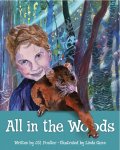
 0 Comments on How not to do a Book Launch?! as of 2/3/2012 4:20:00 AM
0 Comments on How not to do a Book Launch?! as of 2/3/2012 4:20:00 AM
By Danielle Venton
For millions of years, the stout, muscular Przewalski’s horse freely roamed the high grasslands of Central Asia. By the mid-1960s, these, the last of the wild horses, were virtually extinct: a result of hunting, habitat loss, and cross breeding with domestic horses.
Recovering from a tiny population of 12 individuals and only four purebred females, there are now nearly 2,000 Przewalski’s horses around the world. Once again, the light-colored horses, standing about 13 hands, or 1.3 meters, tall, are beginning to graze on the Asian steppe, thanks to captive breeding and reintroduction programs.
Protecting Przewalski’s horses, listed as critically endangered by the International Union for Conservation of Nature, will require far more than protecting their habitat. Understanding and safeguarding their genetic diversity is key, said Kateryna Makova, an evolutionary genomicist at Pennsylvania State University. In a new study (Goto et al. 2011), Makova and her colleagues Hiroki Goto, Oliver Ryder, and others report on the most complete genetic analysis of Przewalski’s horses to date, clarifying previous genetic analyses that were inconclusive.
Because Przewalksi’s horses are the only remaining wild horses, many people have hypothesized that they gave rise to modern domestic horses. The Australian Brumbies or the American Mustangs, sometimes referred to as wild horses, are actually feral domestic horses, adapted to life in the wild. Przewalski’s horses are not the direct progenitors of modern domestic horses, Makova and her colleagues conclude, but split approximately 0.12 Ma. Horses were likely domesticated several times on the Eurasian steppes. It is not known where and when the first event took place. Recent excavations in Kazakhstan indicate humans were using domestic horses as early as 5,500 years ago.
 Przewalski’s horse and offspring
Przewalski’s horse and offspring
The team base their findings on a complete sequencing of the mitochondrial genome and a partial sequencing, between 1% and 2%, of the nuclear genome. They used one horse from each of the historical matrilineal lines. After processing the DNA samples with massively parallel sequencing technology, they compared the Przewalski’s horses to each other, to domestic Thoroughbred horses, and to an outgroup, the Somali wild ass.
Their results carry several implications for breeding strategies. Przewalski’s horses and domestic horses come from different evolutionary gene pools, so breeders should avoid crosses with domestic horses, they advise. Przewalski’s horses and domestic horses have a different number of chromosomes (66 for the former, compared with 64); yet their offspring are fertile (with 65 chromosomes). The hybrids are viable because they differ only by a centric fusion translocation, also called a Robertsonian translocation. The process of pairing chromosomes during meiosis is not disrupted. Cross breeding should be a last resort, if too few Przewalski’s horses are available. Their analysis also suggests that, since diverging, Przewalski’s and domestic horses have both retained joint ancestral genes and swapped genes between populations. One of the two current major blood lines, the “Prague” line, is known to have a Mongol pony as one of its ancestors. The other primary line, the “Munich” line, is believed to be pure. However, because the two groups have historically mixed, keeping “pure” Przewalski’s horses from Przewalski’s horses with known domestic horse contributions might not be necessary, the authors write.





































































Wonderfully written article, written from the heart. The family is so rushed in todays time but will so regret these days if they don’t take advantage of what they have right outside their backdoors. Parents need to appreciate the great outdoors inorder for our children to apprecite it.